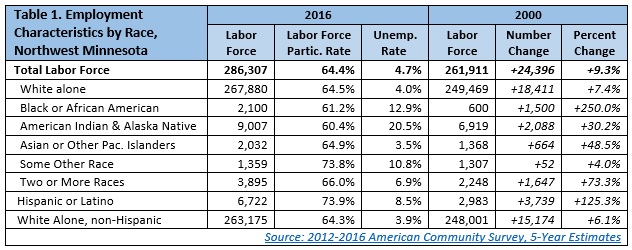 The presence of such industry powerhouses as Polaris, Arctic Cat and New Flyer make Northwest Minnesota a hub of transportation equipment manufacturing.
The presence of such industry powerhouses as Polaris, Arctic Cat and New Flyer make Northwest Minnesota a hub of transportation equipment manufacturing.
From wheat and potatoes to soybeans and sugar beets, the region is a major producer and processor of food staples and specialty agricultural products.
Want the freshest data delivered by email? Subscribe to our regional newsletters.
5/23/2018 12:04:56 PM
Chet Bodin
Despite the pending labor force shortage that Northwest Minnesota communities have been anticipating, the region has continued to add workers year after year. One distinct feature of recent labor force growth is the ethnic and racial makeup of new workers. In 2016, there were over 9,000 more minority workers than in 2000 (Table 1). This influx represents 40 percent of the region’s overall labor force growth since the turn of the century, even though minorities accounted for less than six percent of the labor force before the demographic shift began.

Since 2000, there has been growth in the labor force of every major racial and ethnic group in the region. Three of the five major race groups in Northwest Minnesota added over 1,500 workers each, including Black or African Americans (+1,500), American Indian and Alaska Natives (+2,088), and people identifying as Two or More Races (+1,647).
In both 2000 and 2016, American Indians and Alaska Natives represented the largest minority group in Northwest Minnesota, and their presence in the labor force increased by over 30 percent during that stretch of time. But even though they added the largest number of minority workers to the labor force, all but one other race group grew at a faster pace, leading to a more diverse workforce. In 2016, the region’s Black or African American labor force was estimated to be three and a half times larger than in 2000. The increase of Asians or Other Pacific Islanders and people of Two or More Races also outpaced that of American Indians, growing at 48.5 and 73.3 percent, respectively.
The Hispanic or Latino population, which is an ethnic category rather than a race group, added more workers than any other minority group (+3,739). Most Hispanics identify as being white, however, approximately 500 of the new Hispanic or Latino labor force participants identified as a minority race as well. The net increase from 2000 to 2016 in Hispanic or Latino labor force entrants exceeded that of any race by more than 1,000 workers. In total, the number of Hispanic or Latino workers of any race more than doubled, and when compared to categories of race, only the Black or African American labor force had a higher rate of increase in the region.
It’s clear that the emerging minority workforce is a vital part of the economy in Northwest Minnesota, and that there are opportunities for others to make the region their home and earn a sustainable living. Many regional job vacancies offer wages that meet or exceed what a single person needs to cover the basic needs cost of living, and others offer a track toward higher earnings over time for families needing to earn more. The median hourly wage in Northwest Minnesota now stands at $17.38, enough for most individuals and families to make ends meet – and then some. Overall, there has been momentum toward diversification in the region, and if more workers follow, there are employers and communities in Northwest Minnesota ready to invest in them.
Contact Chet Bodin.